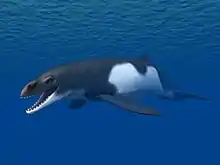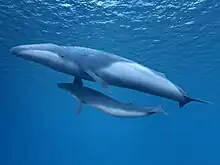| Cetotheriopsis | |
|---|---|
 | |
| C. lintianus | |
| Scientific classification | |
| Domain: | Eukaryota |
| Kingdom: | Animalia |
| Phylum: | Chordata |
| Class: | Mammalia |
| Order: | Artiodactyla |
| Infraorder: | Cetacea |
| Family: | †Cetotheriopsidae |
| Genus: | †Cetotheriopsis Brandt 1871 |
| Species | |
| |
Cetotheriopsis is a genus of extinct cetaceans of the family Cetotheriopsidae.[1]
Taxonomy
The type species of this genus, C. lintianus, was originally described as a species of Balaenodon (a genus of extinct sperm whale) by German paleontologist Hermann von Meyer.[2] It was eventually recognized as distinct from the type species of Balaenodon, and it was given the new generic name Stenodon. However, it was later renamed Cetotheriopsis because Stenodon had already been used for a gastropod by Constantine Samuel Rafinesque in 1818.[3] For his part, Pierre-Joseph van Beneden coined Aulocetus as a replacement name for Stenodon, unaware of the earlier replacement name.[4] Since Cetotheriopsis has priority over Aulocetus and both were based on the same type species, Aulocetus is a junior objective synonym of Cetotheriopsis.
Misassigned species
Aulocetus sammarinensis was formerly assigned to this genus, but is now recognized as a distinct genus, Titanocetus. Two other species from Italy assigned to Cetotheriopsis, Aulocetus lovisati and A. calaritanus, are also generically distinct and in need of new generic names.[5]
Aulocetus latus, known from a Tortonian-age formation in Portugal,[6] is in need of the new generic name.[7]
References
- ↑ Steeman, M. E. (2007). "Cladistic analysis and a revised classification of fossil and recent mysticetes". Zoological Journal of the Linnean Society. 150 (4): 875. doi:10.1111/j.1096-3642.2007.00313.x.
- ↑ H. v. Meyer. 1849. [Letter on various fossils]. Neues Jahrbuch fur Mineralogie, Geognosie, Geologie und Petrefakten-Kunde 1849:547-550
- ↑ J. F. Brandt. 1871. Bericht uber den Fortgang meiner Studien uber di Cetaceen, welche das grosse zur Tertiarzeit von Mitteleuropa bis Centralasien hinein ausgedehnte Meeresbechen bevolkerten. Bulletin de l'Academie Imperiale de St. Petersbourg 1871:563-566
- ↑ P. J. Van Beneden. 1875. Les ossements fossiles du genre Aulocete au Musee de Linz. Bulletins de l'Academie Royale des Sciences, des Lettres et des Beaux-Artx de Belgique 40:536-549
- ↑ Bisconti, M. 2006. "Titanocetus, a new baleen whale from the Middle Miocene of northern Italy (Mammalia, Cetacea, Mysticeti)". Journal of Vertebrate Paleontology, 26(2):344-354.
- ↑ R. Kellogg. 1940. On the cetotheres figured by Vandelli. Boletime do Labrotorio Mineralogico e Geologico da Universidade de Lisboa 3(7-8):13-23
- ↑ Joseph J. El Adli, Thomas A. Deméré and Robert W. Boessenecker (2014). "Herpetocetus morrowi (Cetacea: Mysticeti), a new species of diminutive baleen whale from the Upper Pliocene (Piacenzian) of California, USA, with observations on the evolution and relationships of the Cetotheriidae". Zoological Journal of the Linnean Society 170 (2): 400–466. doi:10.1111/zoj.12108.



